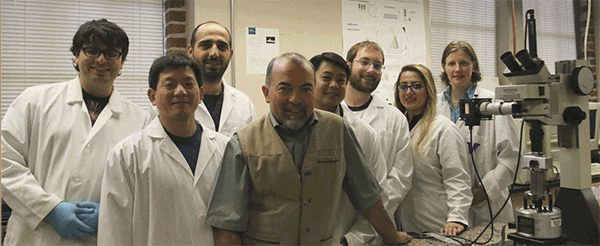Excerpted from The Daily article by Tim Gruver and UW Today article by James Urton
Led by MSE Professor Mehmet Sarikaya, a team of UW engineers is working on new ways of linking our biochemical makeup with non-living materials for treating disease, repairing damaged tissue, and replacing lost limbs.
Though they save and preserve lives, our synthetic treatments are rooted in a chemical language ill-suited to our organic elegance. Implanted electrodes scar, wires overheat, and our bodies struggle against ill-fitting pumps, pipes, or valves.
Sarikaya's team has demonstrated new methods of using proteins to bond with metals and to the calcium compounds that make up our teeth. In a paper published in Scientific Reports, they showed how a genetically engineered peptide, or small protein, can assemble into nanowires on top of solid, two dimensional surfaces that are just a single layer of atoms thick. These nanowire assemblages are critical because the peptides relay information across the bio/nano interface through molecular recognition — the same principles that underlie biochemical interactions such as an antibody binding to its specific antigen or protein binding to DNA.

Depiction of peptides self-assembling into nanowires on a 2-D surface of the semimetal graphene. Image: Mehmet Sarikaya
"As material scientists and engineers, we said, 'Instead of using large proteins, which are very difficult to handle, why don't we use small proteins?'" said Sarikaya, who is also a professor in UW Chemical Engineering and UW Oral Health Sciences. "We could use these peptides as molecular building blocks just like biology is using peptides and proteins as building blocks."
"There is a specific sequence the amino acids actually conform the peptides into three-dimensional molecules," Sarikaya said. "Any given protein interacts with another specific protein or a DNA strand, nothing else."
His team's experiments in the UW Genetically Engineered Materials Science and Engineering Center revealed that GrBP5 spontaneously organized into ordered nanowire patterns when placed atop graphene. After several mutations, GrBP5 also altered the electrical conductivity of a graphene-based device, the first step in transmission of electrical information from graphene to cells through peptides.
"As material scientists and engineers, we said, 'Instead of using large proteins, which are very difficult to handle, why don't we use small proteins? We could use these peptides as molecular building blocks just like biology is using peptides and proteins as building blocks."
According to Sarikaya, these peptides could have great technological and medical applications as effective semiconductors with gold and silica, two minerals common in dental implants. These peptides could also form the chemical basis for organic, less toxic toothpastes, gels, and teeth whitening agents.
Sarikaya's team modified GrBP5 to produce similar results on a semiconductor material, molybdenum disulfide, by converting a chemical signal to an optical signal. They also computationally predicted how different arrangements of GrBP5 nanowires would affect the electrical conduction or optical signal of each material, showing additional potential within GrBP5’s physical properties.
"[Peptides] are like a kangaroo, jumping on the surface," Sarikaya said. "So we can control how the peptide behaves on the surface of a crystal, whether it walks, jumps, or forms an organized pattern or disorganized pattern, which manifests itself in changing the bioelectrical characteristics of a device."
The team further produced similar results by modifying GrBP5 with another semiconductor material, molybdenum disulfide, showing that different arrangements of GrBP5 nanowires would regulate the electrical conduction or optical signal of each material, which could mean additional potential within GrBP5’s physical properties. "We did something crazy. At least, our biochemistry colleagues thought we did something crazy," Sarikaya said. "We said, 'we're going to mutate this peptide' or in other words,''we're going to change the sequence to figure out which part of the sequence sticks to the surface and which part is allowing the two-dimension to self-assemble.'"
"In a way, we're at the flood gates. Now we need to explore the basic properties of this bridge and how we can modify it to permit the flow of ‘information’ from electronic and photonic devices to biological systems."
"In a way, we're at the flood gates," said Sarikaya. "Now we need to explore the basic properties of this bridge and how we can modify it to permit the flow of ‘information’ from electronic and photonic devices to biological systems."
This is the focus of a new endeavor funded by the National Science Foundation’s Materials Genome Initiative. It will be led by Sarikaya and joined by UW professors Xiaodong Xu, René Overney and Valerie Daggett. Through UW’s CoMotion, he is also working with Amazon to cross that bio/nano divide for nano-sensors to detect early stages of pancreatic cancer.
Lead author on the paper is former UW postdoctoral researcher Yuhei Hayamizu, who is now an associate professor at the Tokyo Institute of Technology. Co-authors include two former UW researchers — Christopher So, now with the Naval Research Laboratory, and Sefa Dag, now with IBM — as well as graduate students Tamon Page and David Starkebaum. The research was funded by the NSF, the UW, the National Institutes of Health and the Japan Science and Technology Agency.

"In the future, we should be able to genetically engineer device characteristics," Sarika said. "In 20 to 30 years, all devices will act as both technological and biological components. That's our hope."
For more information, contact Mehmet Sarikaya at 206-543-0724 or sarikaya@uw.edu
Grant numbers: DMR-0520567, T32CA138312, 25706012, DMR-1629071.